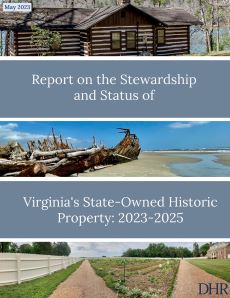 Virginia Department of Historic Resources
Virginia Department of Historic Resources Virginia Department of Historic Resources
Virginia Department of Historic ResourcesReport on the Stewardship and Status of Virginia’s State-Owned Historic Properties, 2023–2025:
 In 2006, the General Assembly passed legislation mandating that the Department of Historic Resources draft two biennial reports, with the option that they might be combined, on the stewardship of state-owned historic properties. Consistent with prior reports, the 2023 report (link below) combines–
In 2006, the General Assembly passed legislation mandating that the Department of Historic Resources draft two biennial reports, with the option that they might be combined, on the stewardship of state-owned historic properties. Consistent with prior reports, the 2023 report (link below) combines–
The report is supplemented with guidance and reference materials located below and in this section of the DHR website. This year’s illustrated report highlights the efforts of Virginia Union University to list several of its historic buildings in the Virginia Landmarks Register and updates to projects led by DHR’s Underwater Archaeology Program.
Report on the Stewardship and Status of Virginia’s State-Owned Historic Properties, 2023—2025:
Recognized as a national preservation leader, Virginia leads the country in preservation stewardship by setting examples in sustainability, economic incentives, battlefield preservation, and groundbreaking achievements in the adaptive reuse of decommissioned military installations. Virginia has a responsibility to manage historic properties owned by state agencies and educational institutions in a manner that provides the greatest public benefit possible.
Legacy of Stewardship
In the United States, preservation was born in Virginia. As early as 1858, the Mount Vernon Ladies Association formed to save Mount Vernon from neglect in the first organized effort to preserve a historic landmark. The oldest statewide preservation organization in America, the Association for the Preservation of Virginia Antiquities (formerly APVA, and currently Preservation Virginia) saved Powder Horn in Williamsburg in 1889, long before Colonial Williamsburg was created.
The Department of Historic Resources (DHR) was created under the National Historic Preservation Act of 1966, when this important legislation led to a State Historic Preservation Office in every state and U.S. Territory, a role DHR serves in Virginia. The NHPA Act also established the National Register of Historic Places, by which the Commonwealth founded the Virginia Landmarks Register that same year, Virginia’s parallel program to the National Register.
The following topics are covered on the Tools page of this website.
State Laws and Regulations
State-Owned Historic Property Inventory
Virginia Landmarks Register & Other Designations
DHR Project Review
DHR Contacts for State Agency Assistance
The following topics are covered on the Best Practices page of this website.
Building Treatment and Maintenance
Green Preservation
Archaeology
Battlefields
Updated May 9, 2023